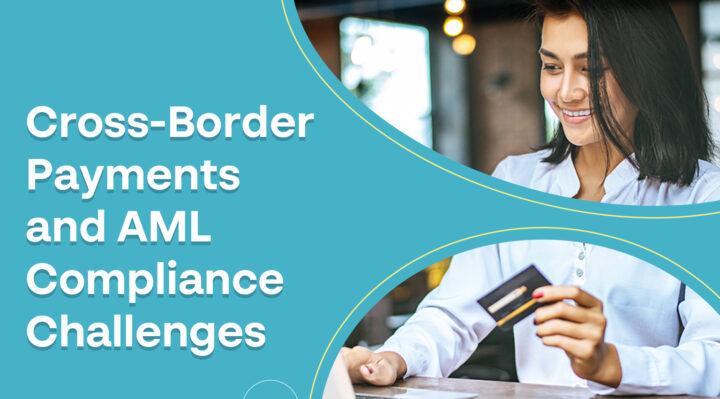
In our modern global economy, money moves across borders with ease, powering international trade and finance. However, this freedom also presents opportunities for financial crimes.
As money flows across nations, so do risks like money laundering and illicit financing. This is where Anti-Money Laundering (AML) compliance comes into play to ensure the honesty and security of financial systems worldwide.
In the pages ahead, we’ll demystify cross-border payments, explaining how they work and why they matter globally. Additionally, we’ll shed light on the crucial role played by AML compliance in safeguarding financial systems from unlawful activities. Join us on this journey to better understand these essential topics in our interconnected world.
Cross-Border Payments and AML Compliance Challenges
A. Understanding Cross-Border Payments
Cross-border payments are financial transactions that bridge the gap between parties in different countries. These transactions can encompass a wide spectrum of activities, ranging from facilitating global trade and cross-border investments to the simple act of sending money from one country to another, often in the form of remittances to support family members abroad.
What makes cross-border payments complex is the multifaceted nature of these transactions. They typically involve a network of financial institutions, each playing a specific role in facilitating the transfer of funds. Moreover, to ensure legality and compliance with international regulations, cross-border payments must navigate a complex web of legal and financial frameworks.
B. Unveiling AML Compliance Challenges
Anti-Money Laundering (AML) compliance is the robust defence mechanism designed to thwart illicit financial activities, such as money laundering and the financing of terrorism. Its overarching goal is to identify and deter these activities, thus ensuring that the global financial system remains transparent, secure, and reliable. However, when it comes to cross-border payments, AML compliance faces a set of distinctive hurdles.
C. The Intersection of Cross-Border Payments and AML Compliance
The pivotal intersection between cross-border payments and AML compliance arises when these financial transactions necessitate the collection, analysis, and verification of customer data to meet stringent AML requirements. In many instances, cross-border payments involve substantial sums of money, making them appealing targets for money launderers and individuals involved in financial crimes.
Within this intersection, the battle against financial crimes takes centre stage. It is here that the efforts to maintain the integrity of international financial systems clash with the sophisticated strategies employed by those seeking to exploit vulnerabilities. Understanding and effectively navigating this intersection is paramount in safeguarding the global financial landscape.
Navigating the Intersection
A. Challenges Faced by Financial Institutions
Financial institutions find themselves at the forefront of the ongoing battle against financial crimes within the intersection of cross-border payments and AML compliance.
Here are some of the significant obstacles they encounter:
1. Global Regulatory Landscape: The web of international AML regulations is extensive and ever-evolving. Complying with this complex regulatory framework can be a daunting task. Non-compliance can lead to severe financial penalties and significant damage to an institution’s reputation.
2. Data Complexity: Cross-border transactions involve vast and intricate datasets. Effectively sifting through this data to identify suspicious activities requires advanced tools and technologies. The sheer volume and diversity of information demand sophisticated data analysis techniques.
3. Customer Verification: Verifying the identities of customers in different jurisdictions presents a multifaceted challenge. Legal requirements for customer due diligence can vary significantly from one country to another. Financial institutions must navigate these complexities while maintaining compliance.
B. Implementation of Appropriate Policies and Procedures
To overcome these formidable challenges, financial organizations must establish robust AML policies and procedures that align seamlessly with both the intricacies of cross-border payments and the diverse array of global regulations.
Here are some critical steps in this process:
1. Robust Risk Assessment: Conduct thorough risk assessments specific to cross-border payment processes. This assessment helps identify vulnerabilities and areas where enhanced due diligence is necessary to mitigate risks effectively.
2. Data Analytics: Implement advanced data analytics and artificial intelligence tools to scrutinize transaction data for irregularities. These technologies enhance the efficiency and accuracy of AML compliance efforts, allowing for more effective risk identification.
3. Compliance Training: Regularly educate and train employees on AML regulations and the nuances of cross-border payments. Ensuring that staff members are well-informed and up-to-date on compliance requirements is vital for success.
C. Protection of Customer Information
At the heart of the intersection lies the safeguarding of customer information, a responsibility that financial institutions must take seriously.
Here are key measures they should adopt:
1. Informed Consent: Communicate to customers how their data will be used and obtain explicit consent for data processing. Transparency and clear communication build trust and ensure compliance with data privacy regulations.
2. Access Control: Strictly control access to sensitive customer data, limiting it to authorized personnel only. Implement robust access controls and maintain detailed audit trails to track data access and usage.
3. Regular Audits: Conduct routine audits to evaluate compliance with data privacy and AML regulations. These audits help identify areas for improvement and ensure that policies and procedures are effectively implemented and maintained.
Conclusion
In international finance, the intersection of cross-border payments and AML compliance holds paramount importance. It signifies not just regulatory compliance but also the frontlines in the battle against financial crimes. Failure to navigate this intricate junction effectively can result in substantial penalties and irreparable damage to reputation.
However, it’s crucial to understand that navigating this complex intersection is not solely a duty; it is a strategic imperative. Financial organizations that invest in robust AML practices and fortify data privacy safeguards do more than meet regulatory requirements. They establish themselves as responsible and trustworthy partners in the global financial ecosystem.
Advanced tools such as artificial intelligence and data analytics offer the means to enhance efficiency and accuracy in AML compliance, thereby fortifying the integrity of cross-border payments.
As financial institutions strive to adapt and innovate, it’s imperative to seek partnerships with trusted solutions that comprehend the intricacies of both cross-border payments and AML compliance.
With Youverify, financial organizations gain a reliable ally, capable of navigating the complex terrain of cross-border payments and AML compliance. Together, we can ensure that the global financial system remains secure, transparent, and resilient in the face of evolving threats.
Join hands with Youverify today to fortify your defences and stride confidently into the future of international finance.



